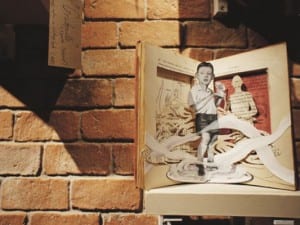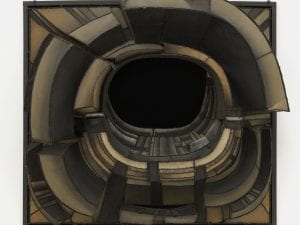Mythical archetypes and molecular science find common ground in the work of Inna Timokhina, an artist-scientist with Siberian gypsy roots. She received formal education in visual arts in Russia and a Ph.D. in Molecular Biology from Cornell University. Inna’s art explores the hidden patterns and energies behind our familiar world, emerging from the viewpoints of microscopic and molecular images of life and from esoteric dreamworlds of the deep psyche. she has been featured at events including Florence Biennale (2013); London Biennale (2013), Chianciano Biennale (2013), Art Monaco (2013 and 2014); and exhibits at galleries in Paris, French Riviera, Chelsea (New York), Ibiza, Red Dot Art Fair (Art Basel Miami week) and a solo exhibit at the Museum of Russian Art (USA).
A: You describe your work as “phantasmagoric dreamworld images” please tell me more about this inspiration.
IT: Using inspiration from my work as a molecular biologist, my paintings depict unusual and dream-like scenes that appear to be in flux and evolving in unexpected and fantastic ways. As my collector noted: “Depending on the mood and the viewpoint of the viewer, Inka’s paintings can trigger different and changing imaginations and emotions”. The energetic aspects of my art, sometimes enhanced with actual light sources and at other times mimicking an “infrared” point of view, like in night vision, contribute to this effect. This alternative interpretation of familiar images has created the notion of “phantasmagoric dreamworld images” that I have also heard from viewers.
A:What has your background in molecular biology meant to you as an artist?
IT: As a scientist, I studied molecular mechanisms of cellular function and worked a lot with microscopic images of living cells and tissues, which represented either healthy or disease conditions. One focus was on energy metabolism, and that work involved measuring energy levels and flow in cells. Having been working on these molecular events and images of living cells, and their energy dynamic, for over 15 years of my life, now as an artist I tend to see the physical world around me as an interplay of energy fields, both synergistic and opposing to each other.
A: How do you balance both your scientific and artistic work?
IT: As a scientist I am mainly involved in entrepreneurial and consulting work, which requires a certain degree of creativity and flexibility. Sometimes I get artistic inspiration from my scientific projects, e.g. “Sensation” was inspired by a scientific project involving sensory biology. My scientific projects can also benefit from my artistic work, e.g. I got an introduction to the Russian entrepreneurial community as a consequence of having a solo exhibition at the Museum of Russian Art in the US. Switching between art and science allows me to take a fresh look at my artistic techniques, and try different approaches. But it is undoubtedly challenging, since both science and art require extreme concentration.
A: Your early influences came from Japanese ink paintings, how does this reflect in your work?
IT: As a child, I was very impressed by a book called Possessed by Art about the 18th century Japanese artist, Katsushika Hokusai. The book was a gift of my first piano teacher when I was 6. I was amused that Hokusai used to practice drawing a flower or an insect hundreds of times in a single movement of a brush stroke. To master such a technique requires a very high level of precision and commitment, since one cannot easily correct mistakes when painting with inks. I also attempt to paint with inks with precise brush strokes and lines, which usually requires a great deal of thinking and visualization beforehand.
A:Where do you see yourself in the future?
IT: In the future I would like to continue to increase the exposure of my art in order to reach a broader audience. I also hope to increase recognition of the beneficial effects art can have. In my art I try to transport the viewer into a realm of pleasant dreamworlds to help reduce stresses of our modern life via harmony of colors and energy patterns. Would you like to step into “Ibiza Dream”? Also, I am currently creating a new collection of artworks, dedicated to music. In this series I will explore even further the significance of rhythmic energy patterns in my art.
To see more of Inna Timokhina’s work please go to www.inkagallery.com
her work can also bee seen at the following upcoming events:
Upcoming events:
JAZZ a Nice Group exhibition dedicated to Jazz. 8 July- 31 July 2014; Galleria Monteoliveto, 5 rue du Lycee, 06000 Nice, France.
La 7eme ART Group exhibition dedicated to the Cinema – during de Festival di Cannes. 14 May – 25 May 2014; Galleria Monteoliveto, 5 rue du Lycee, 06000 Nice, France.
Art Monaco, 24-27 April 2014; Grimaldi Forum, 10 Avenue Princess Grace, Monaco 98000. RED AND WHITE, the colors of Montecarlo.
To see her listing in the Artists’ Directory in Aesthetica Magazine issue 58 pick up a copy at www.aestheticamagazine.com/shop
Credit:
1.Pearls of Passion (2014). Ink, acrylic and LED lights on canvas. 28”H x 22”W
2. Birds of ParadEyes (2011). Ink and acrylic on canvas. 22” H x 28” W







